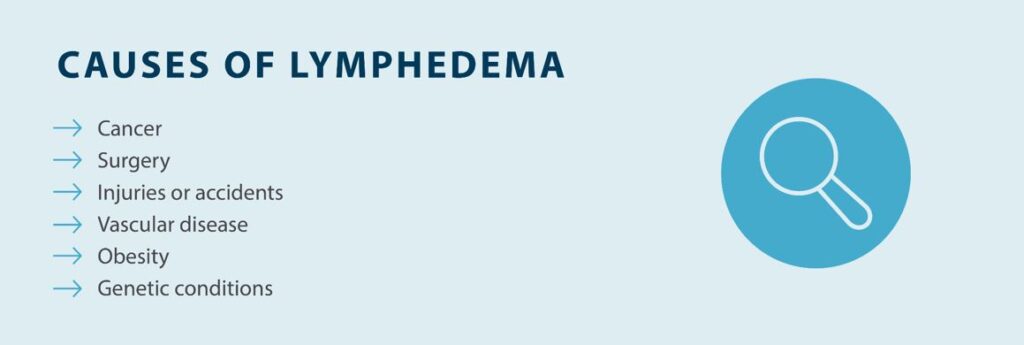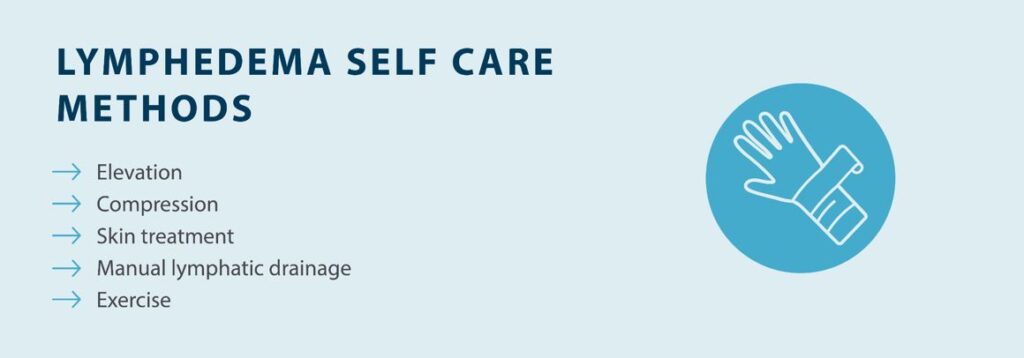Lymphedema and Weight Loss
Living with lymphedema while trying to manage your weight can feel overwhelming, but understanding the connection between lymphedema and weight loss can help you develop effective strategies for both conditions.
Read More

While visiting a doctor for a lymphedema diagnosis is an important first step, lymphedema self care can help you manage your symptoms at home. From wearing compression garments to taking care of your skin to prevent infections, lymphedema home treatment can help you avoid complications and keep your lymphedema in check. So, what is lymphedema, and how can you treat it? If you want to learn more about lymphedema self care, here’s everything you need to know.
What Is Lymphedema?
What Causes Lymphedema?
What Are Lymphedema Home Treatment Options?
Can You Prevent Lymphedema?
When Should You See a Lymphedema Specialist or Doctor?
Try Lymphedema Self Care with Tactile Medical
Lymphedema is a medical condition where fluid from the lymphatic system builds up in the tissues just beneath the skin. Normally, this lymph fluid flows through the lymph vessels and lymph nodes, where it eventually makes its way to one of the two main lymph ducts. These ducts are responsible for releasing lymph fluid back into the bloodstream, which helps maintain blood fluid levels and prevent infections.
Patients with lymphedema have a lymphatic drainage issue, which can result from various problems with the lymphatic system. Lymphatic drainage can be affected by a blocked or removed lymph node or a damaged lymph vessel, both of which can interrupt the flow of lymph fluid and cause swelling.
Understanding the potential causes of lymphedema is an important part of preventing lymphedema, especially for people who are at high risk. While lymphedema is commonly caused by vascular disease, cancer, and surgery, there are several other potential causes and risk factors. Here are some of the most common causes of lymphedema.

The good news is that there are lymphedema self treatment options that can help you get relief from symptoms. The key is complete decongestive therapy, which combines several treatment methods to provide maximum relief. Here are some of the things you can do at home to keep your lymphedema under control.

Elevation
It’s harder for fluid to flow against gravity, so your lymphatic system may have a tough time draining if fluid is building up in your legs. Elevating the affected part of your body can help prevent fluid buildup to reduce swelling in the affected area. If you have acute damage to your lymphatic system, elevating the affected limb can move lymph fluid to a functional part of the lymphatic system, allowing it to drain properly.
If you’re dealing with severe swelling that’s causing discomfort, pain, or decreased range of motion, elevation can be a self management option.
Compression
Wearing compression garments for lymphedema is one of the most popular treatment options. Compression garments apply gentle pressure to the affected limb(s), which helps prevent fluid buildup and encourage the flow of lymph fluid, even when gravity is working against it. There are compression stockings and compression sleeves with different levels of compression available. Before you wear these compression garments, you should talk to your doctor or lymphedema specialist to make sure you’re using them properly.
There are also pneumatic compression devices such as the Flexitouch Plus System from Tactile Medical. These devices help apply gentle pneumatic pressure to facilitate the flow of lymph fluid. Compression garments and pneumatic compression devices aren’t typically used independently. Instead, they are both used as part of a comprehensive treatment program, which may include exercise, manual lymphatic drainage massages, adequate skin and nail care, and a healthy diet. The Flexitouch Plus System is available for lower body, upper body, and head and neck treatment.
Skin treatment
Skincare is another vital part of managing lymphedema. Lymphedema increases your risk of infection if you have an injury, so it’s important to make sure your skin is moisturized properly. You should apply lotion at least once per day and make sure you keep your skin clean and dry otherwise. Cutting your fingernails and toenails can also help prevent scratches, which lowers your risk of infections due to cuts where bacteria can enter.
Manual lymphatic drainage
When it comes to encouraging lymphatic drainage, one of the best things you can do is learn how to do a lymphatic massage. This is a simple technique that involves using your hands to gently guide the flow of lymph fluid. While lymphatic drainage massages are easy to do at home, there’s a very specific method involved. You can talk to your doctor or lymphedema specialist about how to perform a manual lymphatic drainage massage as part of your lymphedema self care treatment plan.
Exercise
Exercise is one of the easiest and most beneficial self care lymphedema therapy steps you can take. Exercise helps encourage blood flow as well as lymphatic drainage, which helps reduce swelling and the symptoms that come along with it. As an added benefit, exercise allows you to keep your weight in check, which is a risk for lymphedema and lymphedema complications.
At the very least, you should try to get about 30 minutes of moderate exercise each day. Daily exercise can be as simple as walking around your neighborhood or performing tasks around your house. If you can’t manage to exercise daily, aim to get 30 minutes of exercise at least four or five days a week.
While it is difficult to prevent lymphedema, there are several steps you can take to slow down its progression and manage your symptoms.
For example, maintaining a healthy weight is perhaps the most important thing you can do to prevent lymphedema because obesity is a risk factor for lymphedema. In fact, some people can develop lymphedema as a result of extreme obesity alone, so eating a healthy diet and getting plenty of exercise can help you manage your weight and the progression of lymphedema.
Staying hydrated can also help you maintain a healthy weight and encourage lymphatic drainage. Since your lymphatic system is made up of mostly water, lymph fluid flows better when you’re well hydrated.
If certain complications arise, you may want to visit a lymphedema specialist or doctor for help. This includes swelling that’s getting progressively worse, especially if you’re taking steps, such as elevation and exercise, to try to relieve swelling at home.
Patients who have blisters or ulcers as a result of lymphedema should also see a specialist or doctor, as these can lead to serious complications, including infections. Finally, you should visit a doctor if lymphedema is causing you serious pain, as that can be a sign of your lymphedema progression or performing a self care technique at home wrong.
Lymphedema self care is an important part of keeping your symptoms in check, from compression therapy to elevation and exercise. If you’re diagnosed with lymphedema, you should talk to your doctor or lymphedema specialist about tips for managing lymphedema symptoms at home.
With Tactile Medical, lymphedema self care is simple. The Flexitouch Plus System from Tactile Medical uses pneumatic compression to help gently encourage lymphatic drainage, reducing swelling, pain, and other symptoms. Our pneumatic compression device is available for head and neck, upper body, and lower body lymphedema treatment. If you need help with lymphedema self care, try our Flexitouch Plus System today.
Living with lymphedema while trying to manage your weight can feel overwhelming, but understanding the connection between lymphedema and weight loss can help you develop effective strategies for both conditions.
Read More
Stage three lymphedema is the most advanced stage of this chronic condition. In this stage, the affected body part might display one or more symptoms, such as significant swelling, alterations in the skin, or recurring episodes of infection. While this stage can be challenging to manage, understanding your condition and...
Read More
When the lymphatic system becomes compromised, fluid buildup can lead to stage 1 lymphedema, a condition marked by mild but noticeable swelling in affected areas. This initial stage is a crucial window for intervention, as proper treatment can prevent progression to more severe stages. Knowing the signs, causes, and treatment...
Read More
Living with stage 2 lymphedema brings unique challenges, but understanding your condition is the first step toward effectively managing it. While this stage marks a point where the condition becomes irreversible, there are many ways to maintain your quality of life and prevent symptoms from progressing. Keep reading to explore...
Read More
Call us at 1.800.575.1900